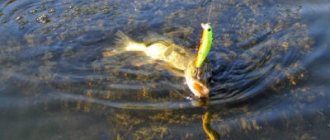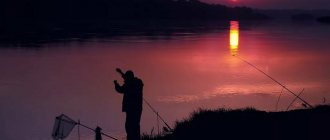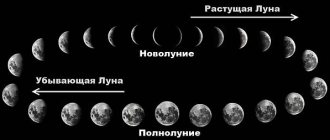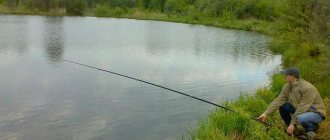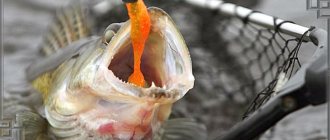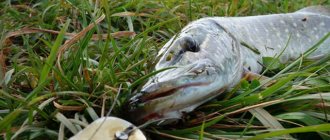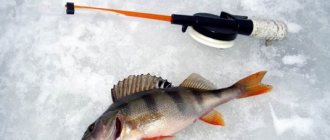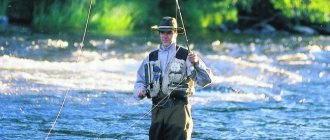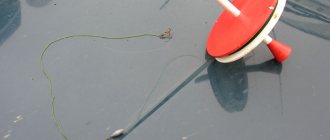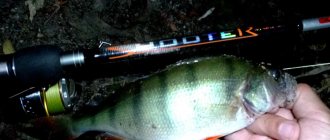Pike is one of the most popular predators and a coveted trophy for many anglers. It is a common catch, since this fish can be found in most domestic reservoirs, and its fishing is relevant throughout the year.
At different periods of the season, her behavior and lifestyle changes, which must be taken into account in order to get a good catch: a detailed calendar of the toothy predator’s biting will help in this matter.
Detailed pike biting calendar
The pike bite is influenced by a large number of different factors, including atmospheric pressure, wind speed, temperature, water purity and transparency. The calendar is universal, but it may contain small errors due to weather conditions in a particular year or the climate of individual regions.
The monthly bite forecasts are listed below:
- In January, the chances of a big catch are minimal, since the fish are at great depths and are characterized by passive behavior. During thaws, the chances of a bite increase significantly.
- In the first week of February the situation is the same as in January.
- In mid-to-late February, the chances of getting a bite are much higher.
- The beginning of March is a good period for pike fishing, especially in the southern regions and the middle zone, where the ice begins to melt; however, this predator activity is temporary.
- In the middle and end of March, the bite worsens and the pike becomes passive.
- In early April, the chances of biting are minimal. In the middle and end of the month, the likelihood of successful fishing increases if you choose the right bait.
- The whole of May is a favorable month for pike fishing; you can use any bait.
- Throughout June, a good bite remains, but it is necessary to monitor the movements of the predator in the reservoir in order to select the right places for fishing.
- In July, the bite worsens, especially in the southern regions, since hot weather makes the prey too passive.
- The chances of a bite in early August depend on the weather and air temperature; towards the end of the month the pike becomes active again.
- The whole of September is a very prosperous month for pike fishing, especially during the daytime. The approach of winter provokes zhor, the fish builds up fat before the onset of cold weather.
- In October, the normal bite continues, but it should be taken into account that the fish move further from the shore during this period.
- In the first half of November, the bite is usually the same as in October.
- In the second half of November it gets significantly colder, which negatively affects the activity of fish and the bite worsens.
- In December, the bite is usually quite good; if there are no sudden changes in temperature or weather changes, then pike can be found in shallow areas of reservoirs.
Lures
The toothy beast is a fish that can be caught using any artificial bait. There are legends about its greed, so the question of what to use to catch pike in September is solved quite simply.
To catch pike in September using a spinning rod, use the following baits:
- "rubber";
- minnow;
- vibrators;
- cranks;
- turntables.
Topwater lures, spinnerbaits and the like are losing their relevance. The best lures for pike in early autumn are minnow class wobblers and silicone. These two diametrically opposite directions make it possible to successfully catch a toothy predator, regardless of the chosen reservoir.
Good results are achieved with oscillating spoons, which begin to work confidently towards the end of the month. How to catch pike in September with iron depends on the reservoir, but in most cases the bait is cast in the bottom horizon. The shaker can be fed evenly, stepwise, or in waves. The main thing is to place the bait as close as possible to the pike site.
At shallow depths, it is advisable to use rotating spoons. These baits are clearly visible to predators from a long distance and can provoke even a passive pike to bite. Good spinners for shallow water include models with rounded petals.
Lunar calendar of pike biting
The phases of the moon can also influence the behavior of a toothy predator; taking into account this feature, forecasts for biting each year are virtually the same:
- During the new moon, it is better to avoid fishing trips, since the likelihood of successfully catching a pike will be minimal.
- The first quarter is a much more successful period, during which the fish become more active and show interest in most of the baits used.
- During a full moon, it is recommended to pay attention to weather conditions, as they will have a more significant impact on prey behavior than the phase of the moon.
- During the last quarter, the predator becomes more aggressive, so this period can also be considered successful for fishing.
Winter fishing
There is a direct connection between the moon and the behavior of fish during winter fishing. Experienced fishermen advise following generally accepted recommendations:
- The approaching full moon is not the time for winter fishing.
- The change in bite in winter is noted at the new moon. The fish's appetite becomes weak, it practically does not move around the reservoir. Even a serious predator is forced by such conditions to stay in certain areas of the reservoir and not move in search of food.
In winter, it is difficult to choose suitable conditions in order to experience high activity and feeding of the predator, which is also complemented by a lack of oxygen in the space under the ice.
Should you trust the calendar?
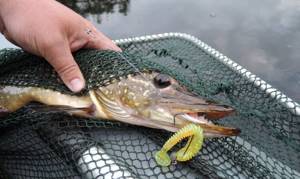
Pike is common in many bodies of water, so its behavior and habits may vary in different regions. However, as practice shows, most biting calendars contain reliable information and can be trusted, although sometimes there are exceptional cases.
Most often they are associated with various natural disasters or abnormal weather: such factors can make a change in the usual way of life of a predator.
Which pike fishing calendar should I use?
When fishing for pike, you can rely on the lunar calendar or the standard calendar, in which bite forecasts are determined depending on the changing seasons and changes in weather conditions.
Both options are equally reliable, but it is important not to forget to take into account the individual characteristics of a particular reservoir, which determine the behavior of the prey, as well as the weather at a given time.
Tackle
Spinning fishing involves the use of diverse baits and methods of presenting them, which is why different tackles are used. A universal pike kit looks like this:
- Braided line with breaking load up to 5–7 kg.
- The spinning rod is about 2.40 meters, medium action, with a test for baits up to 35 grams.
- Power spinning reel size 3000–4000.
If you catch pike with a jig from the shore, then choose a fast-action fishing rod with a height of 2.70 meters. When hunting from a boat, as well as for twitching, it is necessary to use a “stick” 2.10 meters long, fast action, with a powerful butt and a thin sensitive tip.
Advice! When fishing with a spinner, use monofilament fishing line. She spins less. When fishing on a spinner, the braid quickly twists, begins to tangle and becomes unusable.
Don't forget about the leash! It will protect the equipment from the sharp teeth of the pike. Depending on the baits and fishing methods, you can use soft braided leader material, steel “twist”, or fluorocarbon line. Each option, naturally, has its advantages and disadvantages.
Fishing for pike in the spring
Success during spring fishing depends primarily on the climatic conditions of the region: in warm regions, where the ice begins to melt actively in early March, pike begins to bite the earliest and can be caught using spinning gear.
In March
March is a favorite month for many anglers who go to the reservoirs for pike. In this case, it is necessary to know and take into account the following features:
- The active bite persists only at the beginning of the month; at this time you can use both various artificial baits and live bait.
- Towards the middle or end of the month, the pike’s appetite disappears due to the approaching spawning. At this time, fishing bans begin to apply in many regions.
- The most promising places to search for a toothy predator are the borders of coastal thickets and clean, clear water, especially if fry of other fish live in these areas.
In April
Depending on the region, pike spawning begins at the very beginning of April or a little later, so in some reservoirs there is a chance of a good catch in the first week of the month.
It is necessary to remember about the bans on catching pike during the spawning period: their start and end dates vary for different rivers and reservoirs, so you should first check the current information.
For successful fishing, it is recommended to consider the following rules:
- In April, artificial baits with a noise effect are the most catchy, so you can use suitable models of wobblers, poppers or fairly large spinners. This is due to the cloudiness of the water in the middle or end of the month, which significantly impairs visibility and forces the fish to rely more on hearing rather than sight.
- It is better to look for pike in the same places where it spawned, since immediately after its completion it begins active hunting.
- It is best to choose small rivers or shallow areas of reservoirs for April fishing, since they warm up much faster, which has a positive effect on prey activity.
In May
May is an excellent month for pike fishing, especially for novice anglers, since the predator attacks virtually any bait.
During the feeding season you can get a very good catch, but the likelihood of catching trophy specimens at this time is minimal. It is only important to remember that in some regions a May ban on spinning fishing is being introduced.
Relationship between the phase of the moon and the activity of predatory fish
The Moon is the closest celestial body to Earth; the influence of its mass and magnetic field on our planet is difficult to deny. However, the answer to the question of how the lunar cycle affects the inhabitants of water bodies is somewhat more complicated. According to the observations of many fishermen, the pike bite according to the phases of the moon will look something like this:
- New moon. At this time, the Earth's natural satellite is either not visible at all in the night sky, or only its narrow crescent can be seen. Fish activity is unstable, many anglers at this time point to a weak bite, while others, on the contrary, believe that at this time there is the greatest chance of decent catches.
- First quarter period. At this time, fish activity is at an average level; under favorable weather conditions and time of year, it is quite a good time for fishing, although the chances of catching a trophy are not the highest. However, many pike hunters point to increased activity of the predator in the first days of the quarter.
- It is especially important to understand whether pike bite during the full moon. Most anglers tend to believe that this phase of the lunar cycle has the least favorable effect on pike fishing. It will be difficult to catch predatory fish at this time, but if other factors are favorable, then you can count on some kind of catch.
- The time of the last quarter of the lunar cycle, especially the first and last days of this period are considered the most favorable. The pike bite should be active, especially if the weather at this time is favorable, fishing in this case should be especially successful. The main thing is to catch a predator using the bait that is most attractive to it in a particular body of water.

Pike behavior changes depending on the phase of the moon
We catch pike in the summer
The success of summer fishing depends mainly on the temperature, since on hot days all prey becomes passive and does not show any interest in hunting. Below, the fishing features are described in more detail by month.
In June
June is one of the best summer months for fishing, since the water has already warmed up well, there is no intense heat, and the predator continues to actively hunt and gain weight, and with the onset of summer, the May ban on spinning fishing is lifted.
Other features you need to know are as follows:
- The bite reaches its peak in the morning hours, the period from 5:00 to 8:00 is considered the most favorable.
- The prey goes to its permanent summer camps, so when visiting familiar bodies of water, finding it will not be difficult.
- If you are visiting a reservoir for the first time, it is recommended to look for a toothy predator in dense underwater thickets.
- The most effective are considered to be various models of artificial baits - wobblers or spinners.
In July
In July, the success of fishing will depend on the weather, since in extreme heat, large specimens stop hunting, and there is still a chance of catching only small pikes.
If you want to catch a large predator, you can try to use the largest models of walkers, since in this case the pike will try to drive the competitor out of its territory.
In August
In August, the situation in many reservoirs improves, as the water temperature gradually becomes lower and large predators become more active again.
This becomes especially noticeable closer to the middle of the month: you don’t have to bother yourself with searching for promising places or choosing bait; During this period, there is a lot of potential prey in reservoirs and pike are actively biting in virtually any area.
Fishing with mugs
Live bait is a good choice for catching pike in September. The best tackle for fishing with this bait are mugs. They are used on lakes, reservoirs, oxbow lakes and river backwaters, ponds and quarries. This direction is inferior in dynamics and sportiness to spinning, but with the proper approach it shows stable results.
Various live baits are used to catch pike with mugs. They can be caught directly on the reservoir with a fly rod, or you can bring them with you in spacious containers called canas. One of the best baits for toothy predators is small carp. He is unusually tenacious and actively behaves on the hook.

Mugs are the best way to fish for live bait in September
For productive fishing, it is enough to use no more than ten mugs. If you install more gear, it will be problematic to keep track of them, they will get confused, and the angler will not be able to fully concentrate on catching pike.
September is one of the best months for pike fishing. It is recommended for a beginner who likes to fish for predators to master the hunt for the spotted beast during this period, since it is quite easy to catch it in early autumn. In addition, at this time there is a high probability of a large pike biting, which forces many anglers to go to reservoirs in search of fishing luck.
Fishing for pike in the fall
Autumn is considered the most favorable period for catching pike, since it begins to eat, but its duration is much longer than in spring.
In September
September is a good month for fishing as the August fish activity continues. The secrets to getting an impressive catch are as follows:
- The predator actively builds up fat before winter, so it is recommended to use the largest models of wobblers or spinners; Artificial baits with a noise effect demonstrate a high degree of effectiveness.
- In September, pike remain in their summer camps; you should look for them in underwater thickets.
- In September there is a good chance of catching trophy specimens; you can catch them at great depths using a spinning rod or a float rod; It is best to cast from a boat.
In October
In October you can also count on a catch, but for this you should take into account the following changes:
- It is recommended to use only artificial baits, since it can be difficult to find sufficiently active and mobile live bait at this time of year.
- Pike continues to actively hunt, but at the same time it leaves its usual summer camps. You should look for it at great depths, away from the coastline and shallow areas.
In November
November is the most successful month for catching trophy specimens; the main secrets of successful fishing are discussed below:
- At the end of autumn, the main factor influencing the bite is the weather, so you should go fishing on cloudy and rainy days.
- The most effective bait for November fishing is vibrating tails or oscillating spoons; Sometimes blue or green balancers perform well.
- During the daytime, the probability of a bite is minimal; the predator is much more active in the late evening or early morning hours.
- It is best to look for prey near the bottom surface, where it feeds on dead fish.
Fishing for pike in winter
In winter, the activity of pike decreases significantly, but many people still go to water bodies for it, since, unlike most other popular breeds, it does not hibernate.
December
In December, changes in the behavior of the prey are very noticeable: it hunts less and does not gather in schools, so even catching one pike does not guarantee that a promising fishing spot has been discovered
During this month, you should avoid days when the weather changes or the air temperature drops sharply; Fishing on the first ice is considered the most successful.
In January
In January, many anglers go to reservoirs, but catching pike will require a lot of effort. This is the most unfavorable winter month for fishing; the chance of a catch increases only during a thaw, when the predator experiences a short-term increase in interest in hunting.
Special winter models of spinners are considered the most successful bait; fishing with the help of girders is also promising.
In February
In February, pike gradually become more active as they sense the end of winter and the approaching warmth of spring. More and more people start going fishing this month; you can continue to use lures or catch a predator with spoons, but the chance of a bite also increases when using live bait.
When studying the biting calendar, you can understand that the probability of catching pike with proper preparation is present throughout the year. It is best for beginners to go fishing in May-June or August-September, when the predator is most active.
Gradually gaining experience, you can move on to catching a toothy predator at other times of the year, when this process will be more complex, but no less interesting and exciting.
Lures and bait for pike fishing
Experienced fishermen recommend using various types of spoons in summer. You should not buy bright and flashy baits; it is better to buy a dark-colored spinner. Since pike may not be particularly active in summer, it is better to select bait at the fishing spot.
It is not advisable to use a popper, although it attracts with sound, but only because of this the fish will not rise from the depths. You can catch a pike with a popper only if it swims nearby.
In the autumn, spinners, wobblers and twisters are often used. It is best to choose large baits.
For winter fishing, it is best to choose balancers, spoons and live bait. When choosing moving lures, those with horizontal movement are best.
In spring, it is preferable to choose balancers, spoons, wobblers, and also add living creatures, such as a worm, to the bait.
